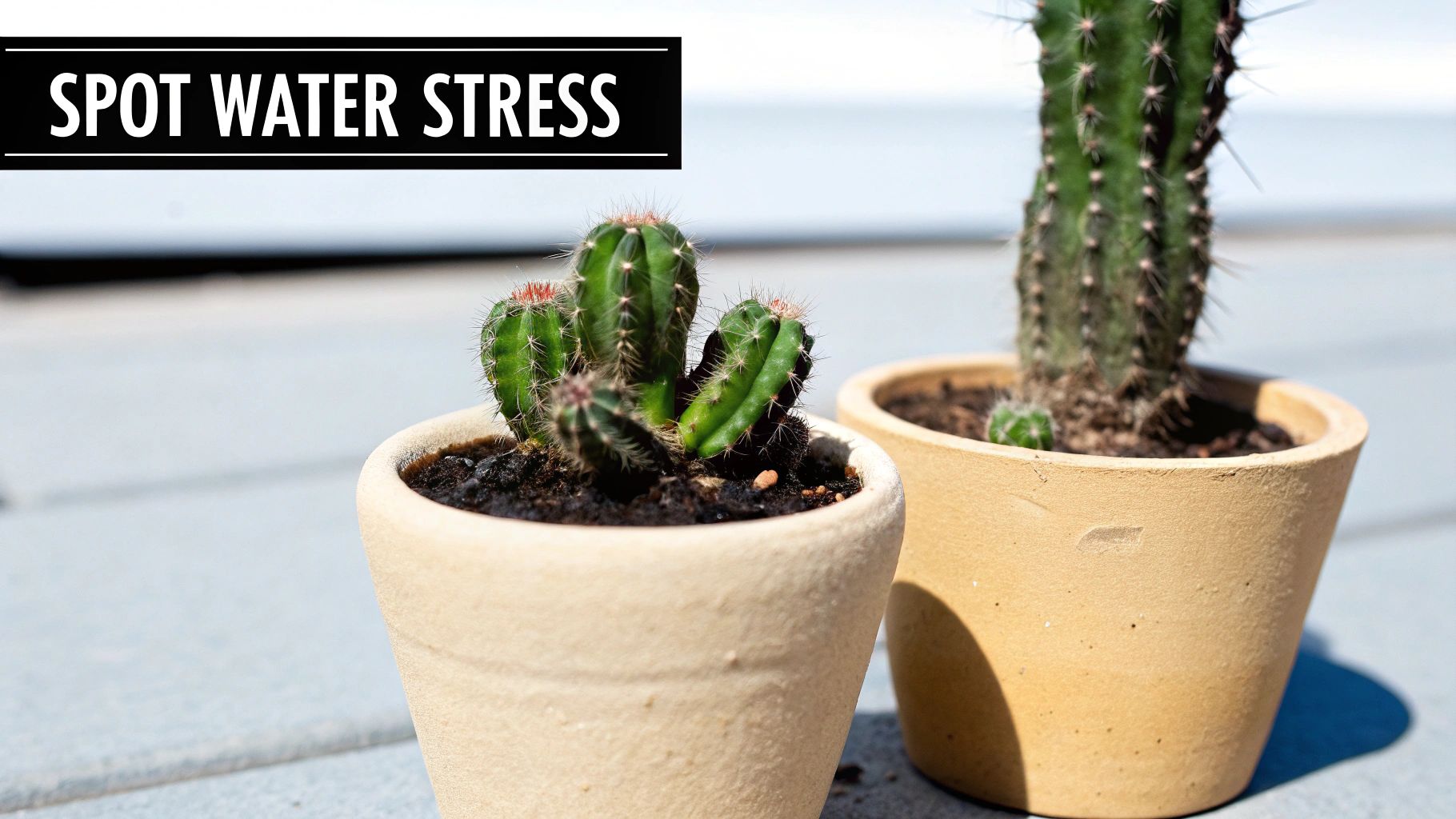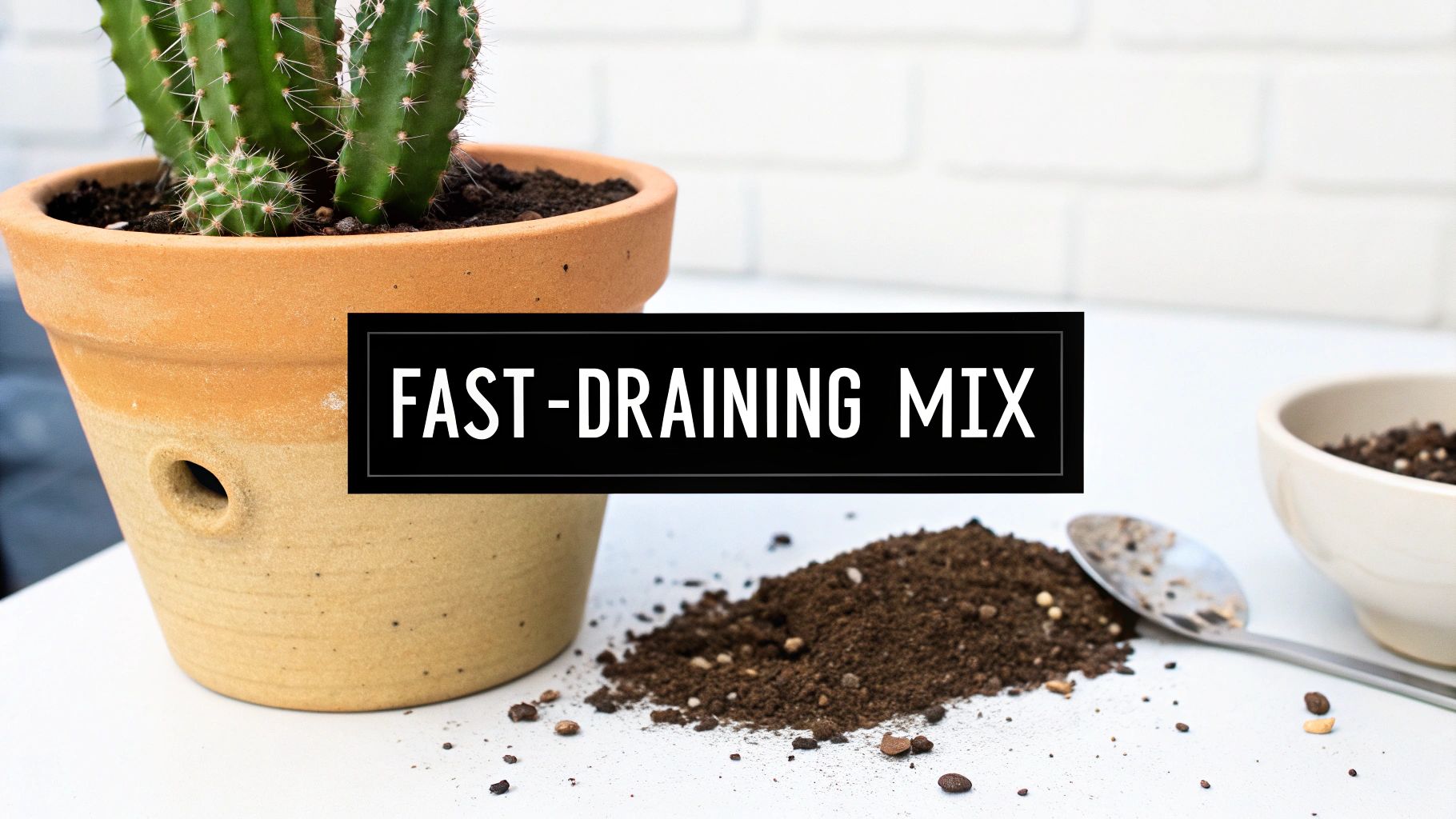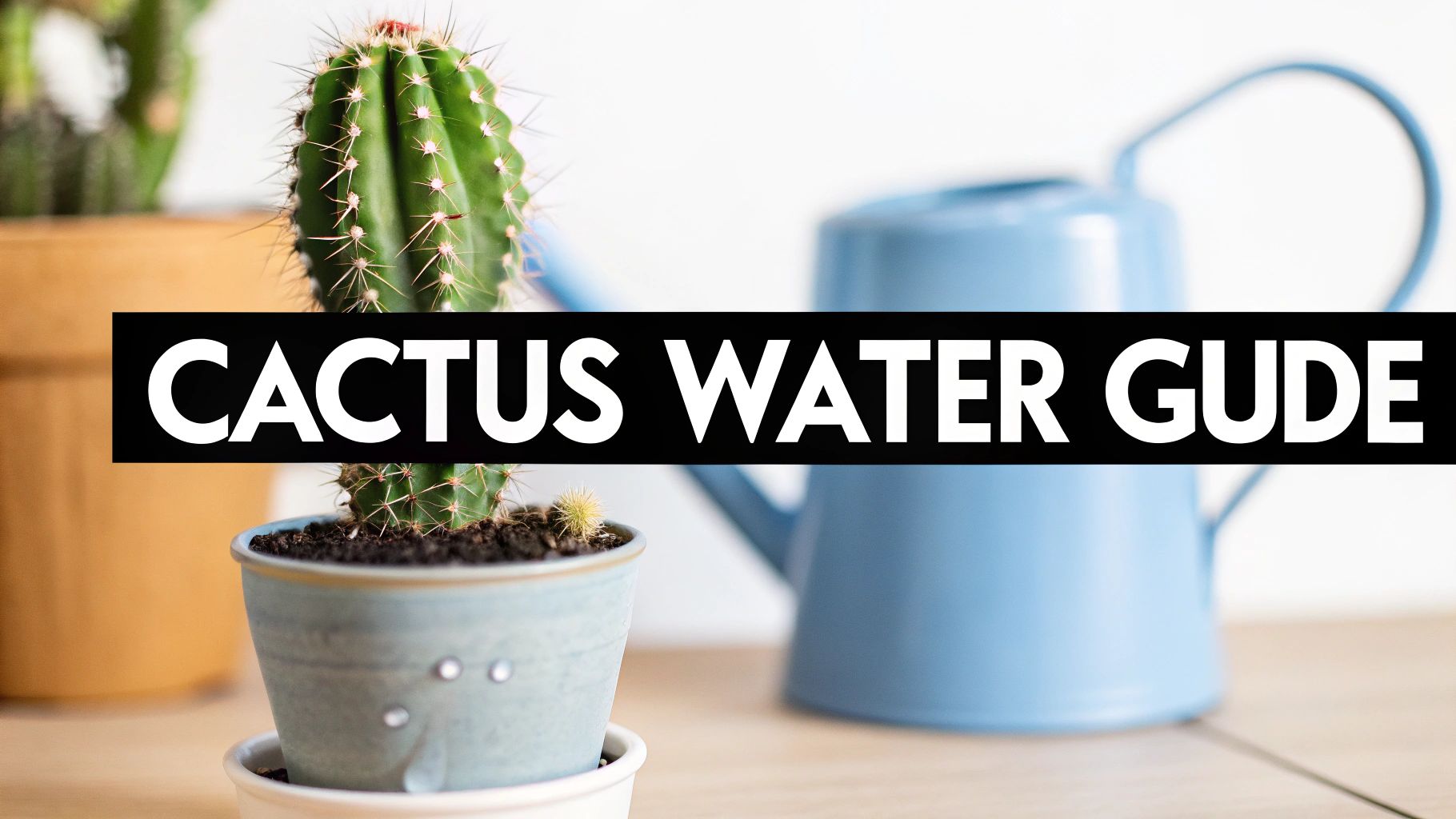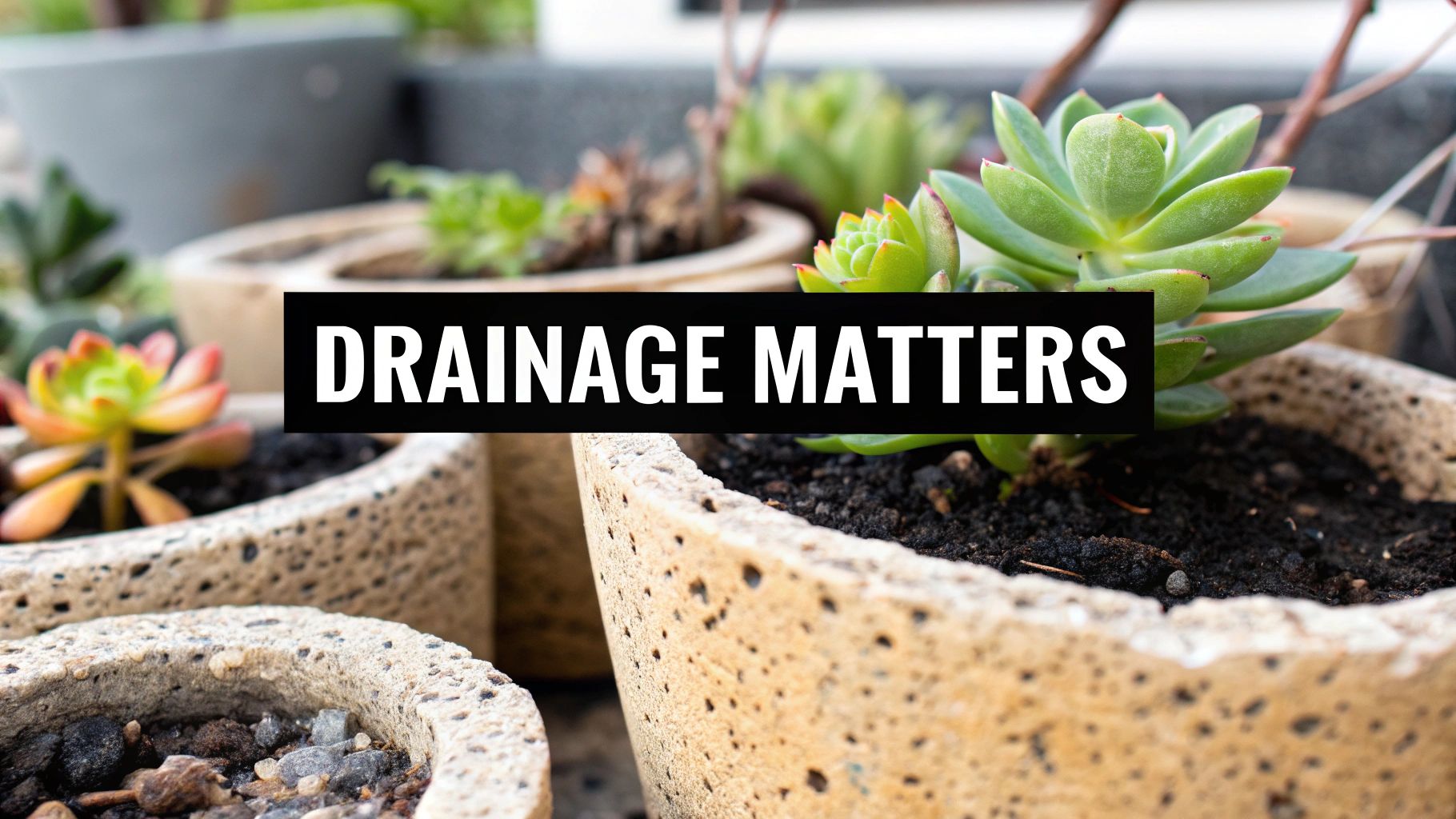When people ask, "How much water does a cactus need?" they're often looking for a simple, one-size-fits-all answer. The truth is, it's less about a strict schedule and more about mastering one key technique. The golden rule I always come back to is the "soak and dry" method.
This approach is all about mimicking the way cacti get water in the wild: rare but intense desert downpours. You drench the soil completely, then let it become bone dry before you even think about watering again.
The Golden Rule of Cactus Watering
Let's clear up a common myth: cacti don't thrive on neglect. They're incredibly resilient, sure, but they don't enjoy being parched forever. What they really love is a deep, thorough drink that soaks their entire root system, followed by a nice long dry spell.
This cycle does wonders for the plant. It encourages the roots to grow deep and strong, searching for that last bit of moisture, which builds a much healthier and more stable cactus.
The "dry" part of this equation is where your judgment comes in. Cacti are brilliant at storing water, allowing them to get through long stretches without a drop of rain. Some species in their native habitats can even go years without a drink! You can learn more about their incredible survival adaptations on the NWF.org website. Your job is to replicate this natural rhythm in your home.
Soaking Is Not Misting
One of the biggest mistakes I see new cactus owners make is lightly misting their plants or just giving them a little splash of water. This is a bad idea for a few reasons:
- Shallow Roots: It only wets the very top layer of soil. This tells the roots to stay near the surface, creating a weak system that can't properly support the plant.
- Thirsty Plant: The deep roots—the ones that do the heavy lifting of absorbing water and nutrients—get absolutely nothing.
- Stem Rot Risk: Letting water sit on the cactus stem, especially if it's humid or there isn't much light, is just asking for fungal problems to move in.
Here's the key takeaway: when it's time to water, commit to it. Pour water all over the soil until it starts running out of the drainage hole at the bottom of the pot. That's your signal that the entire root ball is fully saturated.
Adjusting to Your Environment
Of course, how long it takes for the soil to dry out will change drastically depending on your situation. A cactus baking in the Arizona summer sun is going to need a drink far more often than one sitting inside during a chilly New York winter. Think of your watering frequency as a moving target, not something you circle on a calendar.
If you want to get into the nitty-gritty of building the right schedule, our guide on essential cactus plant watering techniques is a great next step.
But to get you started, I've put together a quick reference table. Use this as a rough guideline, but always trust your finger first—if the soil isn't completely dry, wait.
Cactus Watering At a Glance
This table gives you a general idea of where to start, but remember to adjust based on your specific plant, pot size, and indoor climate.
| Condition | Watering Frequency (Indoor) | Watering Frequency (Outdoor) |
|---|---|---|
| Spring/Summer (Active Growth) | Every 2-4 weeks | Every 1-2 weeks |
| Fall/Winter (Dormancy) | Every 4-8 weeks | Every 3-6 weeks (or less) |
Think of this as your starting point. As you get to know your cactus, you'll develop an instinct for when it's truly thirsty.
How to Judge When and How Much to Water
If you really want to get cactus care right, it's time to ditch the calendar. Thinking in terms of a fixed schedule is the most common mistake I see. Instead, you need to learn to read your plant and its environment. As for the "how much" question, that part's actually simple: every single time you water, you drench the soil completely.
The goal is always a deep, thorough soak. Keep pouring water evenly over the soil until it runs freely from the pot's drainage holes. This approach does two critical things: it ensures the entire root ball gets hydrated, and it helps flush out any mineral salts that can build up over time.
The Art of Knowing When to Water
Now for the real skill: figuring out when it's time for that deep soak. This isn't about counting the days; it's about playing detective with your plant's soil and surroundings.
First, you have to respect the plant's natural rhythm. Cacti are most active in the spring and summer—that’s their growing season, and they’ll be thirstier. Come fall and winter, they enter a dormant period. Think of it as a long nap where their metabolism slows way down, and so do their water needs.
The environment is just as important. A cactus sitting in a hot, south-facing window will chew through its water supply much faster than one in a cooler, less sunny spot. Higher temperatures and more light mean faster evaporation and a thirstier plant.
The only truly reliable way to know if your cactus is thirsty is to check the soil yourself. No gadget or schedule can replace this simple, physical check. It’s the single most important habit for keeping a cactus happy.
This flowchart lays out the basic thought process perfectly.

As you can see, the decision always comes back to one thing: the condition of the soil, not the date on the calendar.
Your Best Tool Is Your Finger
You already own the best moisture meter there is. To see if it's time to water, just stick your finger about two inches deep into the soil. If you feel even a hint of coolness or moisture, walk away. The soil needs to be completely, bone-dry at that depth before you even think about reaching for the watering can.
For bigger pots where your finger can't go deep enough, a plain wooden chopstick or a barbecue skewer works just as well. Here’s what to do:
- Gently push the skewer deep into the soil, aiming for the middle of the pot.
- Let it sit there for a minute or two.
- Pull it out and inspect it. If it comes out totally clean and dry, it's watering time. If you see dark, damp soil clinging to it, give it a few more days and test again.
Cacti are unbelievably efficient with water. Their entire biology is built to survive drought. In fact, some studies show that cacti need only 20% of the water that conventional crops do to stay productive. It’s a trait that makes them fascinating plants for arid agriculture, as highlighted in this research on prickly pear from the University of Nevada, Reno's Agricultural Experiment Station.
Because of this incredible resilience, it is always safer to underwater your cactus than to overwater it. If you're ever on the fence, just wait.
Reading the Signs of Watering Stress
Your cactus will tell you what it needs—you just have to learn its language. Paying attention to a few simple visual cues is the best way to figure out if your watering routine is on point or if it needs a little tweaking. Changes in color, texture, and even how stable the plant is in its pot are all clear signals. Most of the time, the problem is either too much water or not enough, and luckily, the symptoms for each are pretty distinct.

Identifying Overwatering Symptoms
Let’s get this out of the way: overwatering is the #1 killer of cacti. It’s so easy to do, especially for new owners who want to dote on their plants. Too much water drowns the roots, inviting fungal infections like root rot that can take down a plant with shocking speed.
Keep an eye out for these tell-tale signs, which usually start at the soil line and creep upward:
- Soft, Mushy Base: Go ahead and gently squeeze the base of your cactus. If it feels squishy or soft, that’s a major red flag. It’s a classic sign the insides are turning to mush from rot.
- Yellowing Stems: A healthy cactus has a vibrant color. If yours is turning a sickly, splotchy yellow, it's a cry for help. It's worth looking into why a cactus is turning yellow, as it can be a symptom of a few different issues.
- An Unstable Plant: A cactus with a healthy root system should be firm in its pot. If you can easily wobble it back and forth, its roots are likely compromised and can't anchor it anymore.
Spotting an Underwatered Cactus
While not as immediately fatal as overwatering, letting your cactus go thirsty for too long will definitely stress it out. Think of a thirsty cactus as a slowly deflating balloon—it's using up all its stored water just to survive. The good news? This is a much easier problem to fix.
A thirsty cactus looks... well, thirsty. You’ll probably see:
- Wrinkles and Shriveling: The skin of the cactus will get wrinkly, just like our skin does when we're dehydrated. The pads or stems might also look noticeably thinner than they used to.
- Dull, Faded Color: Instead of a rich green, the plant might look a bit dusty, pale, or washed out.
- Limp or Droopy Stems: While some drooping is normal for certain species, a plant that’s clearly less firm and perky than usual is probably asking for a deep drink.
The Quick Touch Test: If you're not sure, just touch it. An overwatered cactus will feel soft and mushy. An underwatered one will feel leathery and deflated. This simple test can tell you almost everything you need to know.
To make things even clearer, I've put together a quick cheat sheet to help you diagnose the problem at a glance.
Overwatered vs Underwatered Cactus Symptoms
Being able to spot the difference confidently is the first—and most important—step to getting your plant back on track. Use this table to quickly compare the signs.
| Symptom | Overwatered Cactus | Underwatered Cactus |
|---|---|---|
| Feel & Texture | Soft, squishy, or mushy at the base | Wrinkled, shriveled, and leathery |
| Color | Yellowing, often starting from the bottom up | Dull, faded, or washed-out green color |
| Structural Integrity | Wobbly, unstable in its pot, may lean or fall over | Appears deflated, thinner, or limp |
| Soil Condition | Consistently damp or wet, may have a sour smell | Bone-dry, may have pulled away from the pot's sides |
Once you know what you’re dealing with, you can take the right steps to nurse your cactus back to health.
Why Soil and Pot Choice Matter
Nailing the soak-and-dry watering method is a huge step, but it's only half the story. If your cactus is stuck in the wrong soil or a bad pot, even the most careful watering schedule can lead to root rot. Think of the soil and pot as your cactus's entire support system—they create the environment where the roots will either flourish or fail.
Your average, all-purpose potting soil from the garden center is a no-go. That stuff is engineered to retain moisture for thirsty tropical plants, which is the exact opposite of what a cactus needs. Cacti roots need to breathe, and they simply can't survive sitting in dense, damp soil for days on end.
This is why a gritty, fast-draining soil mix is absolutely non-negotiable. You want a substrate that lets water rush through it, giving the roots a good drink before drying out quickly. It's all about aeration.

Crafting the Perfect Soil Mix
Mixing your own cactus soil is surprisingly easy and gives you total control over the drainage. I find a simple three-part recipe works wonders for most species.
- One part potting soil: This provides a base of organic matter and a few nutrients.
- One part coarse sand: Make sure it's horticultural sand, not fine play sand, which can compact.
- One part perlite or pumice: These lightweight volcanic rocks are fantastic for creating air pockets, preventing the soil from turning into a solid brick.
Just mix these three ingredients together, and you've got a fantastic, airy medium that your cactus will love. If you want to get more advanced, we have a complete guide to crafting the ideal cactus and succulent soil mix. Making this one change is probably the single best thing you can do to prevent overwatering.
Choosing the Right Container
The pot is just as crucial as the soil inside it. The most critical feature, without a doubt, is a drainage hole. If there's no way for excess water to escape, you’re basically creating a swamp at the bottom of the pot, and root rot is almost guaranteed.
Fallen in love with a decorative pot that doesn't have a hole? No problem. Use it as a "cachepot"—just keep your cactus in its simple plastic nursery pot (with drainage!) and pop it inside the pretty one.
The material of the pot also plays a big role in how often you'll need to water.
Your choice of pot directly influences how quickly the soil dries out. A porous terracotta pot in a sunny window might need water twice as often as the same plant in a glazed ceramic pot in a shadier spot.
Terracotta (unglazed clay) is my top recommendation for beginners and experts alike. The clay is porous, so it "breathes," allowing moisture to evaporate right through the sides of the pot. This helps the soil dry out much faster and more evenly, giving you a great safety net against accidental overwatering.
Plastic or glazed ceramic pots, on the other hand, are non-porous. They trap moisture, meaning evaporation only happens from the top surface of the soil. If you choose one of these, you have to be extra disciplined about checking that the soil is completely dry before even thinking about watering again.
How to Rescue a Struggling Cactus
https://www.youtube.com/embed/EVOPpnhqfzc
Even the most seasoned cactus keeper can run into trouble. One day you look over and your prized plant is just… sad. The good news is that most cacti are incredibly resilient. Whether it's looking mushy from too much attention or shriveled from neglect, there’s almost always a way to bring it back from the brink.
The real emergency is overwatering. Root rot can take a cactus down fast if you don't act quickly. An underwatered, wrinkly cactus, on the other hand, is usually a much simpler fix. Let's walk through the emergency response for both situations.
Reviving an Overwatered Cactus
If your cactus feels soft, squishy, or unstable at its base, you need to act immediately. Think of this as a rescue mission to save the healthy parts of the plant before the rot spreads further.
First things first, gently slide the cactus out of its pot. You need to get a good look at the roots, so carefully brush away all the old, waterlogged soil. Healthy roots are typically firm and white or light-colored. What you're looking for is the bad stuff: roots that are black, mushy, and might even have a swampy smell.
Now, take a deep breath and grab a sharp, sterile knife or a clean pair of shears. You have to be a bit ruthless here for the plant's own good.
- Cut Out All Rot: Trim away every last bit of black, slimy root. Be thorough.
- Check the Plant Base: If the rot has started creeping up into the cactus body itself, you'll need to slice that away, too. Keep cutting until you only see healthy, firm, green tissue.
- Let It Callus Over: Place the trimmed cactus in a dry spot with good air circulation, but out of direct sun. You need to let it sit for several days—maybe even a week—until the cut surfaces have dried and formed a hard callus. This step is critical to prevent infection when you repot.
- Repot into Dry Soil: Once callused, place your cactus in a new pot with fresh, completely dry, well-draining cactus mix. Do not water it for at least a week. This gives the new roots a chance to establish themselves without being immediately swamped.
Patience is your best friend here. Bringing a cactus back from rot isn't an overnight fix. It could be weeks or even months before you spot any new growth, but this surgery is its best shot at a second life.
Rehydrating an Underwatered Cactus
Thankfully, saving a shriveled cactus is far less dramatic. A plant that looks wrinkled or deflated is basically just telling you it's thirsty. The trick is to rehydrate it thoroughly without shocking its already stressed-out system.
The most effective way to do this is with bottom-watering. Find a saucer or a tray, fill it with an inch or two of water, and set the cactus pot right in it. Let the plant sit there and soak up water from the bottom for about 30 to 60 minutes. This method encourages the roots to grow downward and ensures the entire soil mass gets evenly hydrated.
It’s a simple technique, but it works wonders. The water stored inside a cactus is a precious resource—so much so that the packaged cactus water market was valued at USD 43.2 million in 2024. You can find more details about this growing industry in the packaged cactus water market report on Grandviewresearch.com. After a good, long drink from the bottom, your cactus should start to look plump and happy again within a day or two.
Common Cactus Watering Questions
Once you get the hang of the basics, the really specific questions start popping up. These are the tricky, real-world scenarios that can stump even seasoned cactus growers. Let's dig into some of the most common dilemmas to build your confidence.
Should I Mist My Cactus?
This is probably one of the most persistent myths out there. The short answer? No. You should almost never mist a desert cactus.
Their tough, waxy stems aren't built to absorb moisture from the air. Letting water sit on their skin is an open invitation for fungal diseases and rot, especially if you live in a humid area or the plant is in a low-light spot. Misting just wets the surface and does absolutely nothing for the roots down below where the real action happens.
Is Tap Water Okay?
For the most part, yes. Your everyday tap water is perfectly fine for most cacti.
However, if you live somewhere with particularly hard water (meaning it's high in minerals), you might eventually see a white, crusty film build up on the soil's surface or around the rim of the pot. These excess mineral salts can slowly change the soil's pH over time.
It's not usually a deal-breaker, but if you want to be proactive, you can:
- Water with filtered or distilled water every so often to help flush out the mineral buildup.
- Let your tap water sit out in an open container overnight. This allows some of the chlorine to evaporate before you water your plants.
When you're fine-tuning your watering routine, thinking about water quality is a natural next step. For a deeper dive, you can find general advice on water quality from various expert sources.
The No-Drainage Dilemma: I get asked this all the time. Watering a cactus in a pot without a drainage hole is incredibly risky, and I really don't recommend it. If you're stuck with one, the only way is to give it a tiny sip of water—just enough to lightly moisten the soil, never saturate it. But honestly, this is a last-resort measure because the risk of root rot is sky-high.
Wait, Aren't All Cacti Desert Plants?
It’s so important to remember that "cactus" is a massive family of plants. A classic Saguaro from the Sonoran Desert has completely different needs than a tropical epiphyte that grows on trees.
A perfect example is the Christmas Cactus (Schlumbergera). This popular holiday plant is actually native to the humid coastal mountains of Brazil. Unlike its spiny desert relatives, it appreciates more consistent moisture and higher humidity, especially when it's actively growing and flowering. You never want to let these guys dry out completely. Knowing what kind of cactus you actually have is the real secret to getting the watering right.
Ready to add a stunning new succulent to your collection? Explore the incredible variety at The Cactus Outlet and find your perfect plant today by visiting https://www.cactusoutlet.com.




